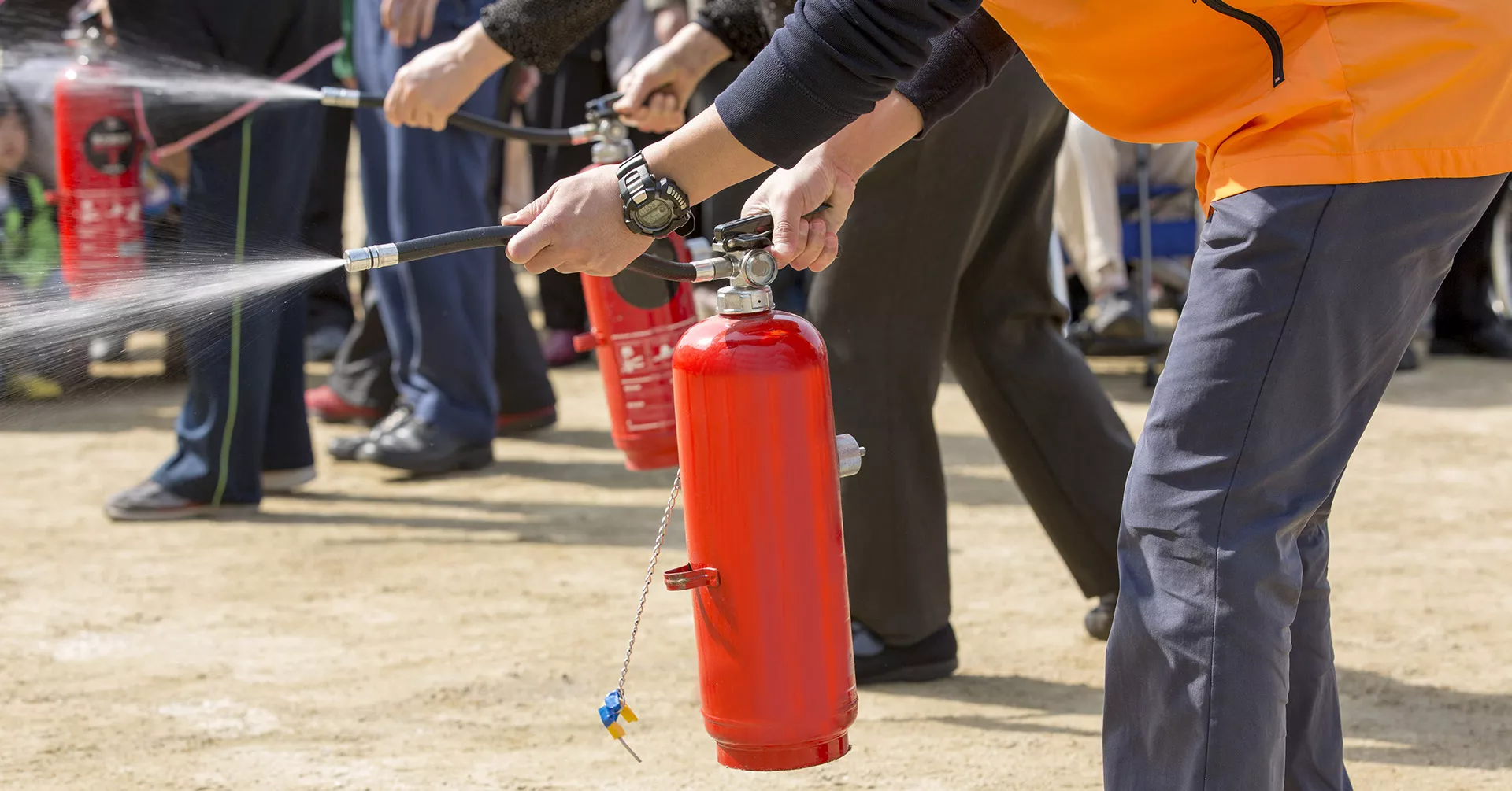
How to Create a Fire Evacuation Plan for Your Business in 7 Steps
When a fire occurs at work, a fire evacuation plan is the best way to ensure everyone gets out safely. All it takes to build your own evacuation plan is seven steps.
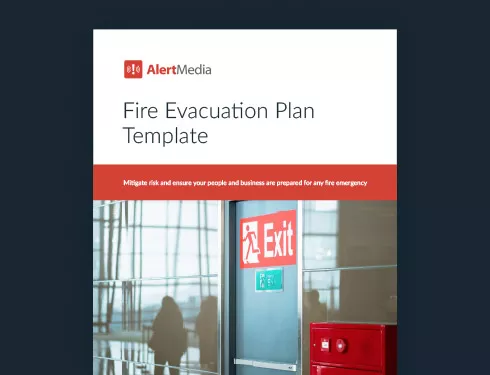
“What if we have to abandon our headquarters with very little notice? What if our primary communication channel goes down? What if our designated assembly point is no longer safe?”
When a fire threatens your employees and business, countless things can go wrong—each with devastating consequences. In mid-2018, an office tower in Sydney, Australia, caught fire, and construction workers on scaffolding had to scramble to safety, racing against the clock as the building’s exterior transformed into a wall of flames.
While fires themselves are dangerous enough, panic and chaos often compound the threat if your company is unprepared. A detailed and rehearsed fire evacuation plan is the best way to prevent this.
A comprehensive evacuation plan prepares your business for various emergencies beyond fires—including natural disasters and active shooter situations. By providing your employees with the proper evacuation training, they can leave the office quickly in case of any emergency.
Download Our Fire Evacuation Plan Template
7 Steps to Create a Fire Evacuation Plan for Your Organization
1. Document fire risks
To organize an effective fire evacuation plan, you need a good grasp of your organization’s fire risks and associated hazards. Start with these fundamental questions to explore the fire-related threats your business may face.
How do fires break out?
The U.S. Fire Administration reported 103,400 fires in nonresidential buildings in 2020, resulting in $3.3 billion in losses. The leading cause of these fires for that year (and the last 20 years prior) was cooking fires. Other common causes were electrical malfunction, heating, and intentional fires such as arson. Knowing these common causes will help you establish your business’s fire hazards and plan to prevent them.
What are your specific risks?
Take some time to brainstorm reasons a fire would threaten your business. Do you have a kitchen in your office? Are people using portable space heaters or personal fridges? Do nearby home fires or wildfires threaten your location(s) each summer? Ensure you understand the threats and how they might impact your facilities and operations.
Since cooking fires are a top concern for office properties, establish rules for using microwaves and other office kitchen appliances. Forbid hot plates, electric grills, and other cooking appliances outside the kitchen area.
What complications might arise?
Develop a list of possible complications by asking, “What if X happens.” Make “X” as business-specific as possible. Consider edge-case scenarios such as:
- “What if authorities evacuate us and we have fifteen refrigerated trucks loaded with our weekly ice cream deliveries?”
- “What if we have to abandon our headquarters with very little notice?”
- “What if a fire breaks down in a high-rise, making evacuation more difficult?”
This exercise helps you elevate a fire incident from something no one imagines into the collective consciousness of your business for true fire preparedness.
What should be included in a fire evacuation plan?
- Clear evacuation procedures
- Evacuation/escape routes
- Assembly point locations
- Key personnel contact information
- A communication plan
- A process to account for those who have evacuated
- Documentation of critical tools/equipment
- Training guidelines and log
- Reporting procedures for fires
2. Establish roles and responsibilities
Employees will look to their leaders for reassurance and guidance when a fire emerges and the business must evacuate. Create a clear chain of command with redundancies that state who has the authority to order an evacuation.
Here are the primary roles you should consider as part of your fire evacuation and safety plan:
- Chief fire warden — This employee has overall responsibility for a fire event, including planning and preparation. The chief fire warden will often ensure doors have been closed, check bathrooms, and perform a backup headcount at a safe location.
- Assistant fire warden — This person uses the mass alert system to notify employees, calls the fire department, and gathers reports. If your company uses an emergency communication system, ensure this person is a system admin.
- Route guides — Route guides are essential in ensuring that routes are clear and evacuation is orderly and calm.
- Floor monitors — The floor monitor is the last person out after ensuring the area is clear. They’ll have an assigned area to cover, ensure all employees evacuate, close doors, and report to the chief fire warden once safe.
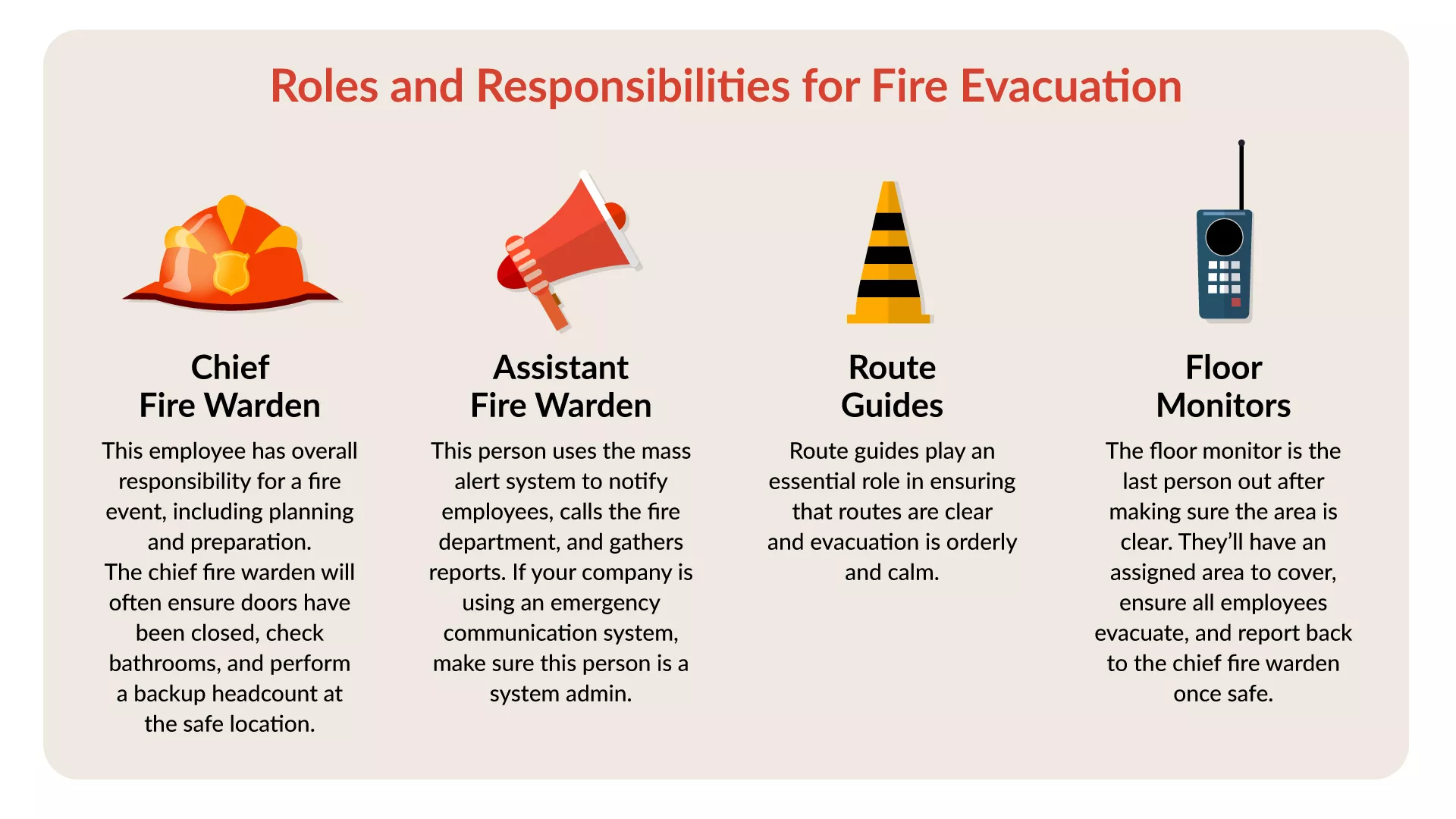 Fire Evacuation Roles and Responsibilities
Fire Evacuation Roles and ResponsibilitiesAs you assign roles, ensure your fire safety team is reliable and can react quickly in an emergency. Additionally, ensure your organization’s fire marshals aren’t too heavily weighted toward one department. For example, sales team members are sometimes more outgoing and likely to volunteer, but you will want to spread responsibilities across multiple departments and locations for better representation.
Document all expectations, as well as contact information, for your fire safety team. The easiest way to do so is by completing a fill-in-the-blank Fire Evacuation Plan Template. You can then distribute your plan and other helpful information, like floor plan evacuation diagrams, to the rest of your company. Hence, everyone knows what to expect and what to do.
3. Determine escape routes, exits, and assembly point
A good fire evacuation plan for your business will include primary and secondary escape routes. Mark all the exit routes and fire escapes with clear signs. Keep exit routes clear of furniture, equipment, or other objects that could impede your employees’ direct means of egress.
Make multiple maps of floor plans and diagrams for large offices and post them so employees know the evacuation routes. Best practice also calls for developing a separate fire escape plan for individuals with disabilities who may need additional assistance.
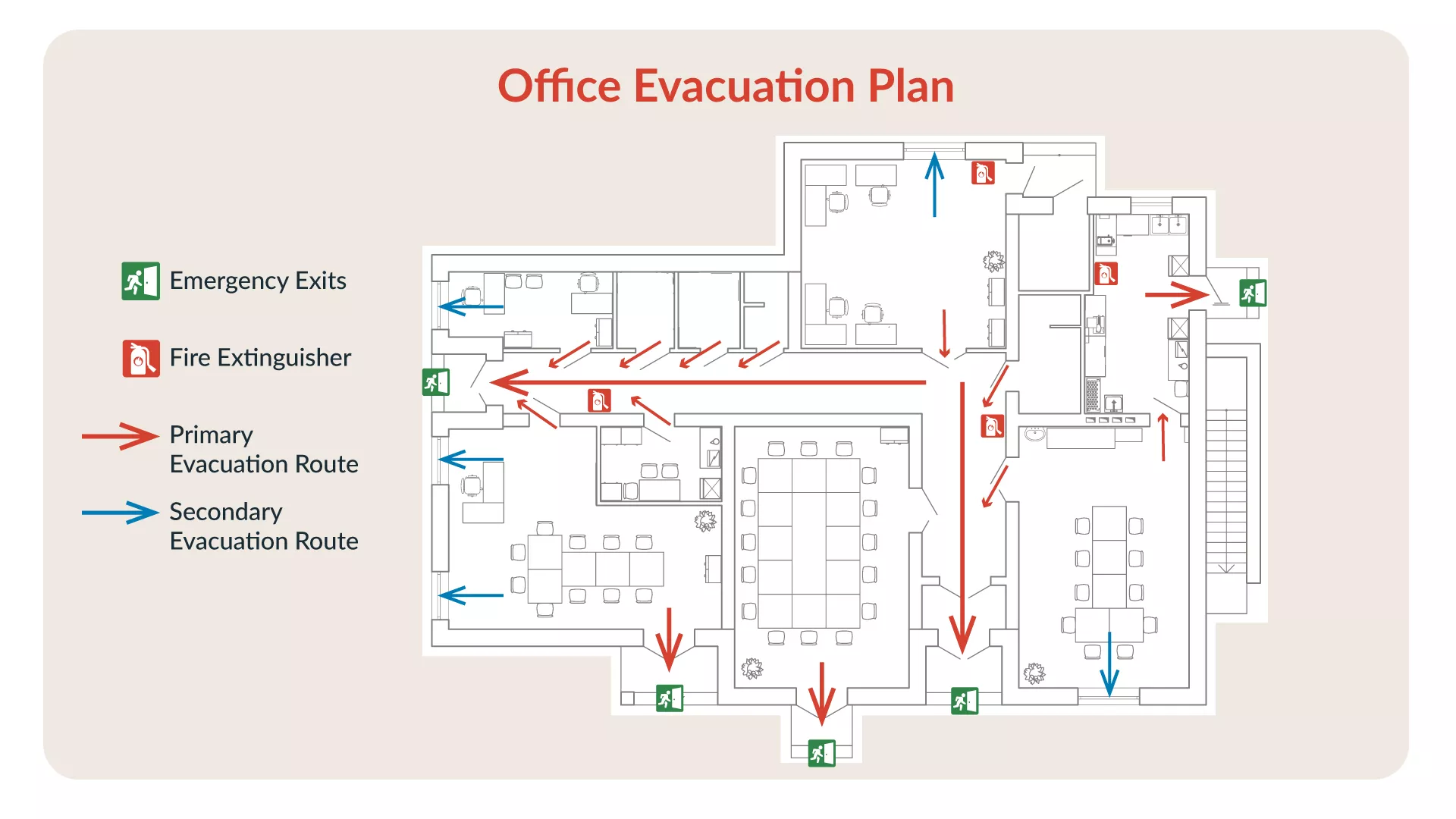 Sample office evacuation plan
Sample office evacuation planOnce your people are out of the facility, where do they go?
Designate a safe assembly point for employees to gather. Assign the assistant fire warden to be at the meeting place to take a headcount and provide updates. If the fire warden is using AlertMedia to communicate, they can use the survey feature to quickly determine who is safe and who is still unaccounted for.
Finally, confirm that the escape routes, any areas of refuge, and the assembly area can accommodate the expected number of employees who will be evacuating.
Every plan should be unique to the business and workspace. An office building might have several floors and many staircases, but a factory or warehouse might have a single wide-open space and equipment to navigate around. Here’s an example of what a fire evacuation floor plan might look like for a hypothetical manufacturing business:
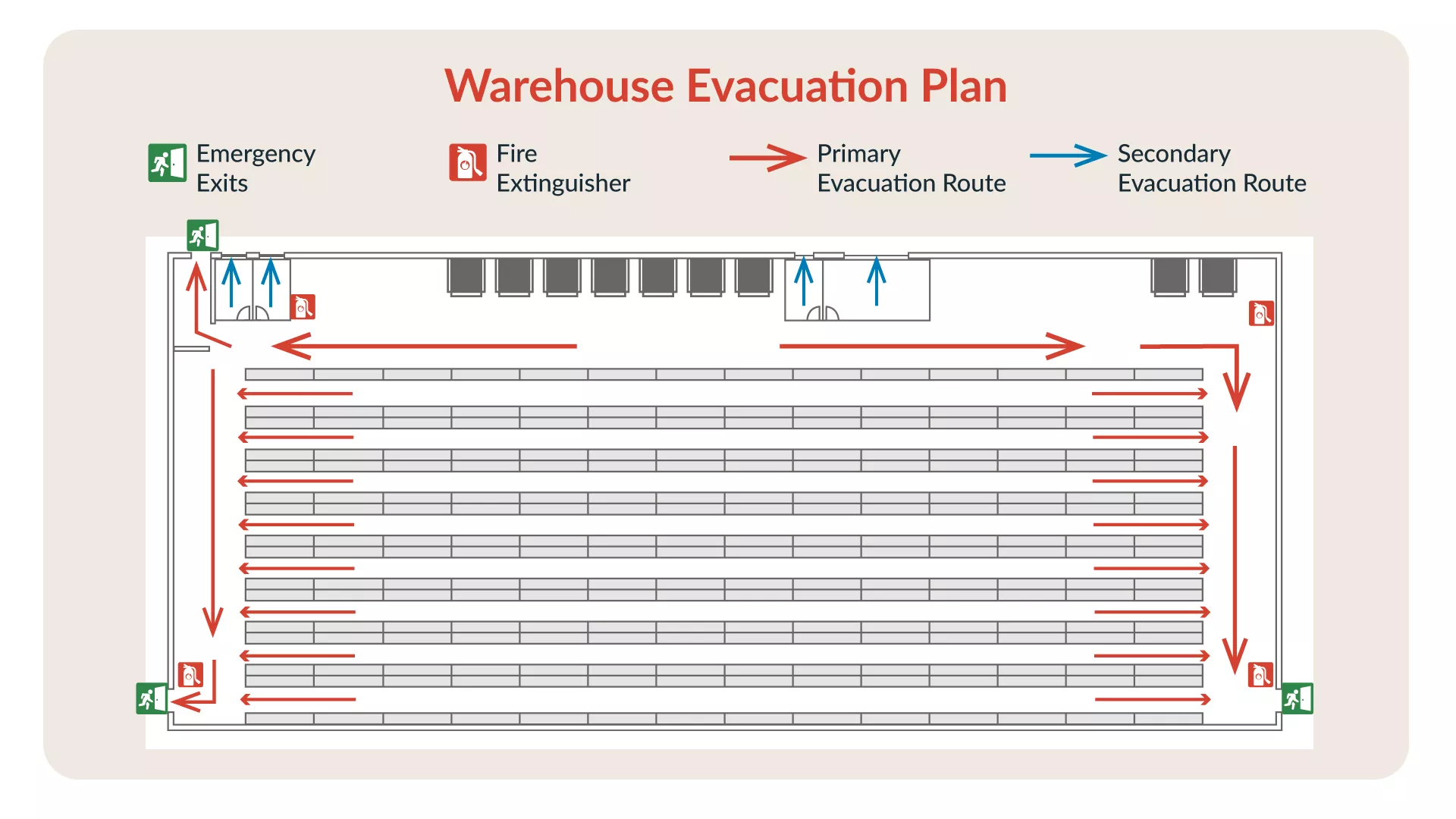 Sample warehouse evacuation plan
Sample warehouse evacuation plan4. Create a communication plan
As you develop your office fire evacuation plans and run fire drills, designate someone (such as the assistant fire warden) whose primary job is to call the fire department and emergency responders—and to disseminate information to key stakeholders, including employees, customers, and the news media. As applicable, assess whether your crisis communication plan should include community outreach, suppliers, transportation partners, and government officials.
Select your communication liaison carefully. To facilitate timely and accurate communication, this person may need to work out of an alternate office if the primary office is impacted by fire (or the threat of fire). As a best practice, you should also train a backup in case your crisis communication leader cannot perform their duties.
Once you have identified this critical role, you must provide them with a robust multichannel emergency communication system. Reacting to a fire can be very chaotic. People may not have access to their regular communication channels, they may forget to check, and networks could fail.
The ability to send notifications through email, phone, text, and mobile app allows you to reach building occupants by preferred and secondary methods of communication, ensuring your messages get the broadest distribution possible. This multichannel approach also enables you to reach the fire department and emergency responders as quickly as possible. An intuitive emergency communication tool, like AlertMedia, makes this seamless. If some employees have evacuated without their personal phones, fire team leaders should also conduct a manual roll call to ensure that every employee is accounted for.
Fire notification examples
Here are a few examples of notifications you might send.
Fire drill
A fire drill will be held in the [LOCATION] office on [DATE] at [TIME]. When the alarm sounds, evacuate the building (avoid elevators) and proceed outside to the emergency rally point.
Fire evacuation
A fire has been reported in the [LOCATION] office. This is NOT a drill! Evacuate the building immediately and await further instructions at the assembly point outside.
Once that tool is in place, your communications team will need to let the appropriate stakeholders know how the situation impacts the business, what actions they should take, the next steps, and more.
5. Understand and inspect fire equipment
Have you inspected those dusty office fire extinguishers in the past year?
The National Fire Protection Association recommends refilling reusable fire extinguishers every 10 years and replacing disposable ones every 12 years. Also, periodically remind your employees about the location of fire extinguishers in the workplace. Create a schedule for confirming other emergency equipment is up-to-date and operable, including:
- Fire alarm systems and smoke alarms
- Emergency lighting
- Fire doors (if applicable)
- Sprinkler systems
- Escape ladders (if applicable)
- Bullhorn, megaphone, or traffic controller wand for fire marshal
In addition to these crucial fire protection supplies, educate your employees about how to use first aid kits in a medical emergency and the utility of everyday office supplies in an emergency. For example, you can use chairs and heavy equipment to break through windows or knock down doors in the case of an actual fire.
6. Rehearse fire evacuation procedures
If you have children in school, you know they practice “fire drills” often, sometimes monthly.
Why?
Conducting regular rehearsals minimizes confusion and helps kids see what a safe fire evacuation looks like, ultimately reducing panic when a real emergency occurs. A safe outcome is more likely to occur with calm students who know what to do during a fire.
“When you're planning drills, it’s important not to have them at a predictable frequency because the nature of fire itself is unpredictable. Employees need to be ready for this irregularity.”Brian O’Connor Technical Services Engineer at National Fire Prevention Association
Research shows that adults benefit from the same approach to learning through repetition. Fires move quickly, and seconds could make a difference, so individual preparedness is necessary ahead of a possible evacuation.
Key fire evacuation leaders should meet quarterly and plan for an annual or semi-annual full rehearsal of the company fire evacuation plan. Consult local fire codes for your facility to ensure you meet safety requirements and that emergency personnel know your organization’s fire escape plan.
We have a detailed guide on conducting a fire drill at work. Make a mini-fire evacuation drill part of a new employee’s onboarding process for bonus points.
7. Follow-up and reporting
During a fire emergency, your company’s safety leadership needs to communicate and track real-time progress. Surveys are an easy way to get status updates from your employees. The assistant fire marshal can send a survey asking for a status update and monitor responses to see who’s safe. Most importantly, the assistant fire marshal can see who hasn’t responded and direct resources to assist those in need.
The biggest challenge is getting reports from people who aren’t in the office. Someone will inevitably be out sick or on vacation. These people obviously won’t be at the rally point, so you may wonder whether they safely made it out of the office.
To account for this discrepancy and clarify everyone’s situation, include response options such as “I’m not in the office today” in your surveys.
If you have a large organization, event pages help keep everyone updated with real-time info. You can provide employees with a web link where they can check for updates.
Tips for a Safe Fire Evacuation
While you likely learned at some point during your childhood to “stop, drop, and roll” if you are on fire, there are other actions you and your employees should take if a fire begins to spread in your office.
Stay low to the ground
If you get caught in smoke, get down and crawl while taking short breaths through your nose. Heat rises, leaving cleaner, cooler air near the floor.
Test door handles
Before opening any doors, feel the doorknob or handle with the back of your hand. If it’s hot, don’t open the door. If it’s cool, open slightly to check if heat or heavy smoke is present. If so, close the door and stay in the room. If you can exit safely, close the door behind you.
Go to the nearest exit, stairwell, or fire escape
Always use a stairwell to evacuate from higher floors, never an elevator. Elevator shafts can fill with smoke, or the power could fail, trapping you inside and putting you in harm’s way. Most stairwell doors are built to keep the fire and smoke out if they are closed and protect you until you can get outside.
Assist others if possible
If you encounter coworkers needing assistance, such as those with mobility issues, help them to the nearest safe exit if you can do so without jeopardizing your safety. If you can’t assist directly, inform emergency personnel about their location.
Do not re-enter the building
Once you’ve evacuated the building, do not go inside for any reason until emergency personnel declare it safe. Re-entering a burning building can be extremely dangerous, as conditions can change rapidly.
More Fire Safety Resources
| How to Conduct Fire Safety Training | How to Conduct a Fire Drill | Fire Emergency Action Plan |
| Fire Safety and Prevention Tips | How to Create a Fire Prevention Plan | Common Fire Hazards in the Workplace |
Other Evacuation Considerations
Some special situations will vary from business to business, but don’t leave these out of your fire evacuation plan.
Plan for workers in all locations
Incorporate contractors, temporary workers, and customers into your plan. Additionally, remote workers might not be directly affected by a fire, but they need to know what is happening with the business and their co-workers.
Make sure to plan for any special needs, such as disabled workers or others who may need assistance evacuating safely. Even if your company doesn’t have permanently disabled employees, it’s crucial to plan for anyone temporarily on crutches or in a wheelchair. These individuals may need additional help during all emergencies, not just fires. Update your company’s emergency response plan annually to include the number of people with disabilities who may require special assistance during an evacuation and their primary work location.
Develop procedures for employees who remain to shut down critical equipment, operate fire extinguishers, or perform other essential services. When developing these procedures, establish strict guidelines for when to abandon this equipment to maintain personal safety.
Plan for asset protection
Are there valuable assets you can easily safeguard or evacuate? For critical items that are too heavy to move, consider storing them in a fire-proof room or safe.
If your business does not have redundant storage for sensitive data, make its protection an immediate priority. Given the relatively low cost of cloud storage, investing in a redundant, cloud-based data storage solution is prudent for any-size business.
Frequently Asked Questions (FAQs)
What should employees do first when there is a fire?
Employees should remain calm and immediately default to the emergency evacuation plan. While proceeding to the nearest designated exit, be sure to use evacuation routes and listen to any additional instructions from your fire team.
Where should we post evacuation plans and maps?
Place signage and evacuation maps in easily visible locations throughout the workplace. Emergency exit doors and elevators are primary locations where evacuation plans can be posted to remind employees of the proper route in a fire emergency scenario. Remember to keep evacuation plans and maps updated to reflect any renovations to your facility.
In case of fire, what should we take with us?
During a fire evacuation, everyone’s top priority should be fleeing from the fire and getting to a safe location. If a worker’s mobile device is immediately accessible, they should take it with them to stay informed and reply to status check-ins. Employees should never stay behind to gather personal belongings.
How do you prepare for a fire evacuation?
In addition to devising a detailed fire evacuation plan and assigning fire team leaders, conduct fire drills to train your employees. Refer to our “How to Conduct a Fire Drill at Work” blog post to learn more.
Who is ultimately responsible for creating the fire evacuation plan?
All organizations should have a fire evacuation plan, but the person responsible for creating it may vary from business to business, depending on the size and structure of your company. It might fall to HR, or you may have a dedicated safety team. Whoever is responsible for other elements of emergency management is a good pick for creating your fire evacuation plan.
How does a fire evacuation plan benefit your workplace?
Fires happen fast, and the best way to ensure all your employees get out in time is to have a comprehensive pre-made plan. It’s also essential to practice the evacuation so your employees have muscle memory. A well-rehearsed plan can save lives if a fire breaks out in your building.
The Steps to a Safe Evacuation Begin Now
With a fire evacuation plan for your business, you’ve taken considerable steps to prioritize fire safety and protect your employees and business assets. People tend to panic in an emergency, but with a good plan, you can prepare ahead of time and make safe outcomes even more likely.

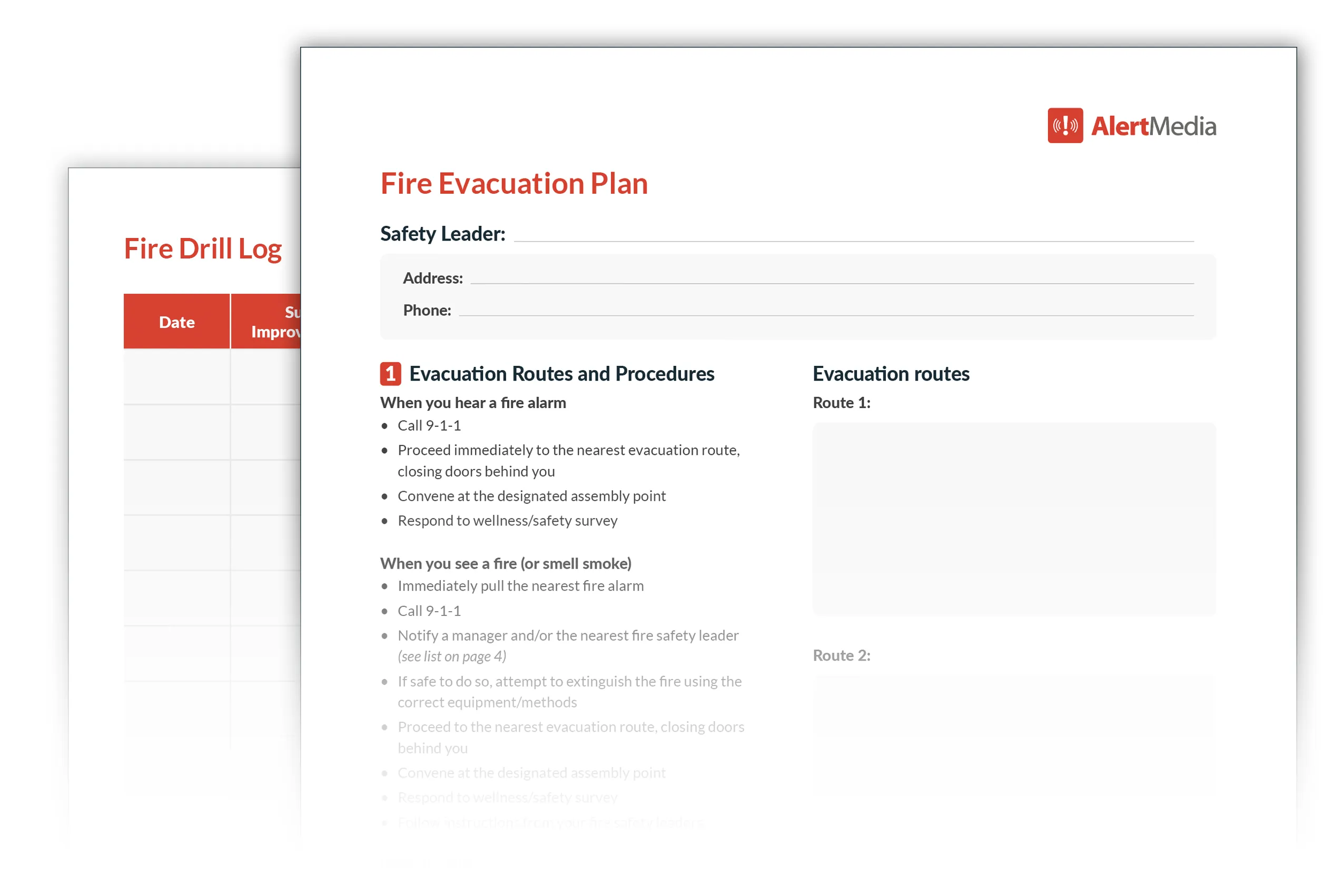

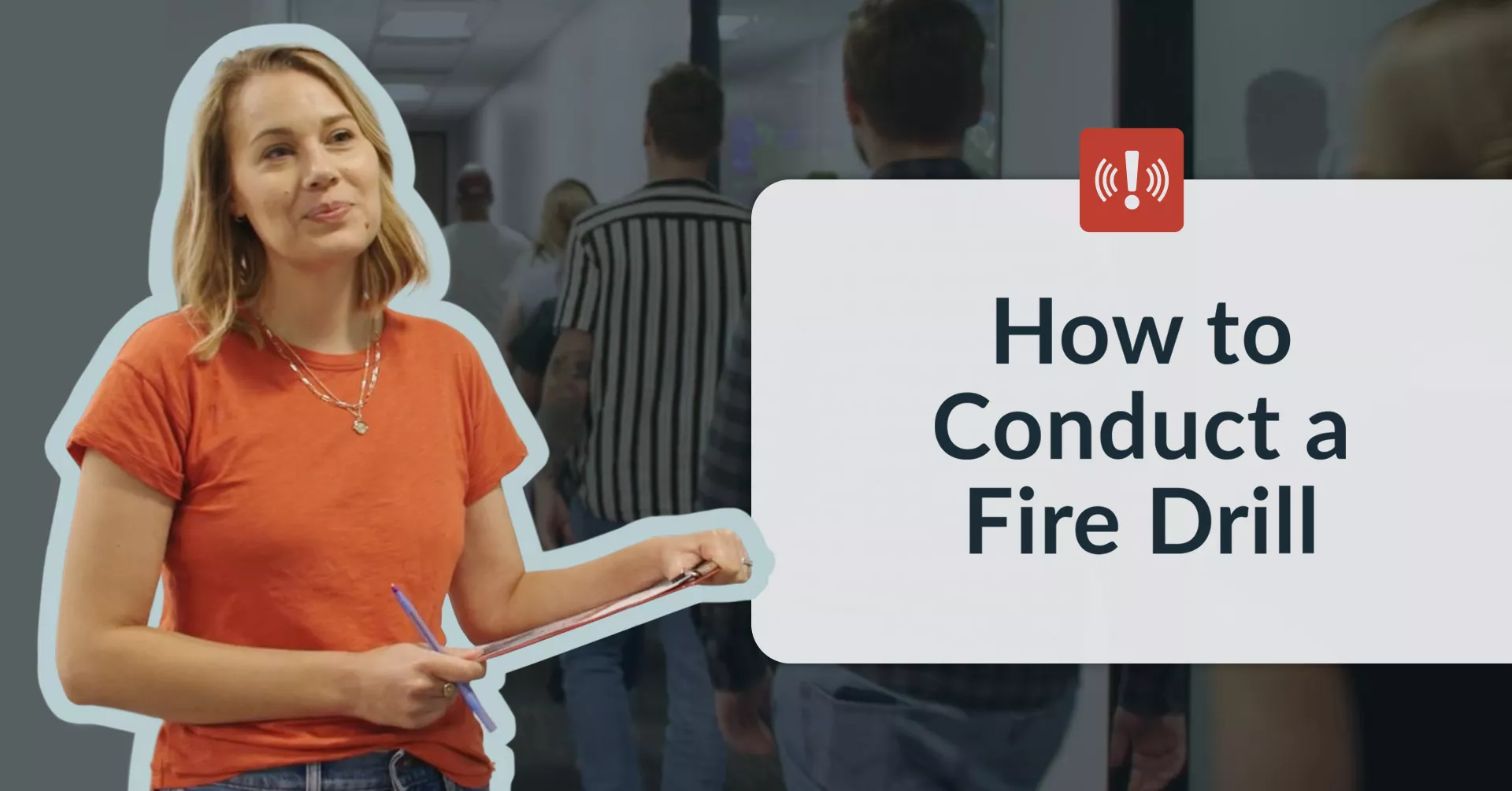
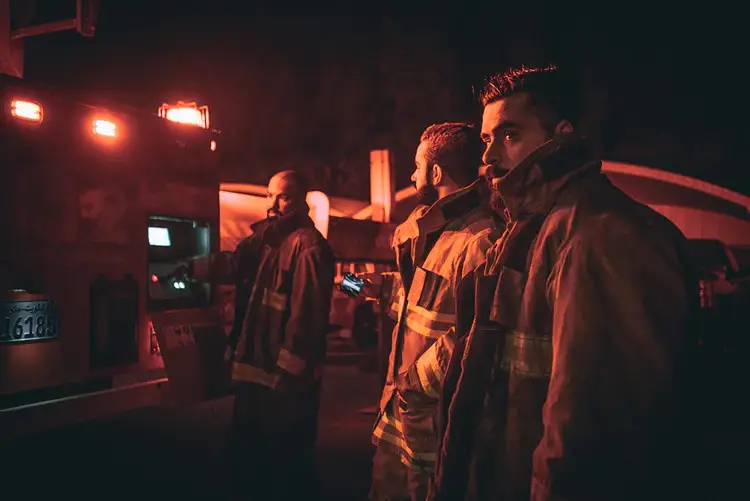
![11 Steps to Creating an Effective Emergency Response Plan [+ Template]](https://www.alertmedia.com/wp-content/uploads/2023/10/Blog-Emergency-Response-Plan.webp)
